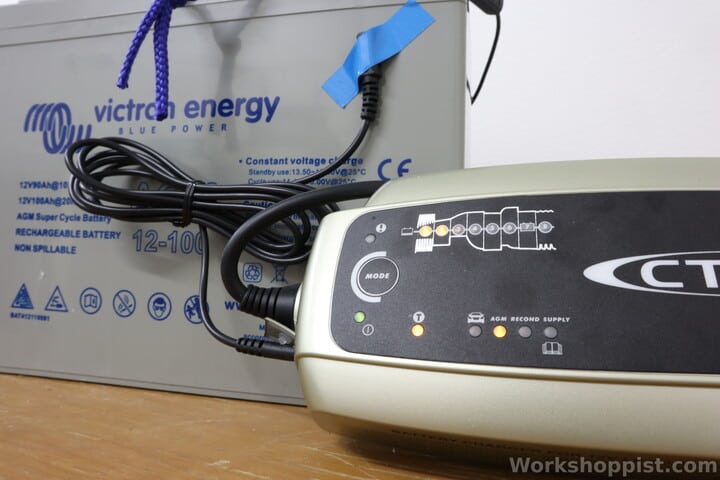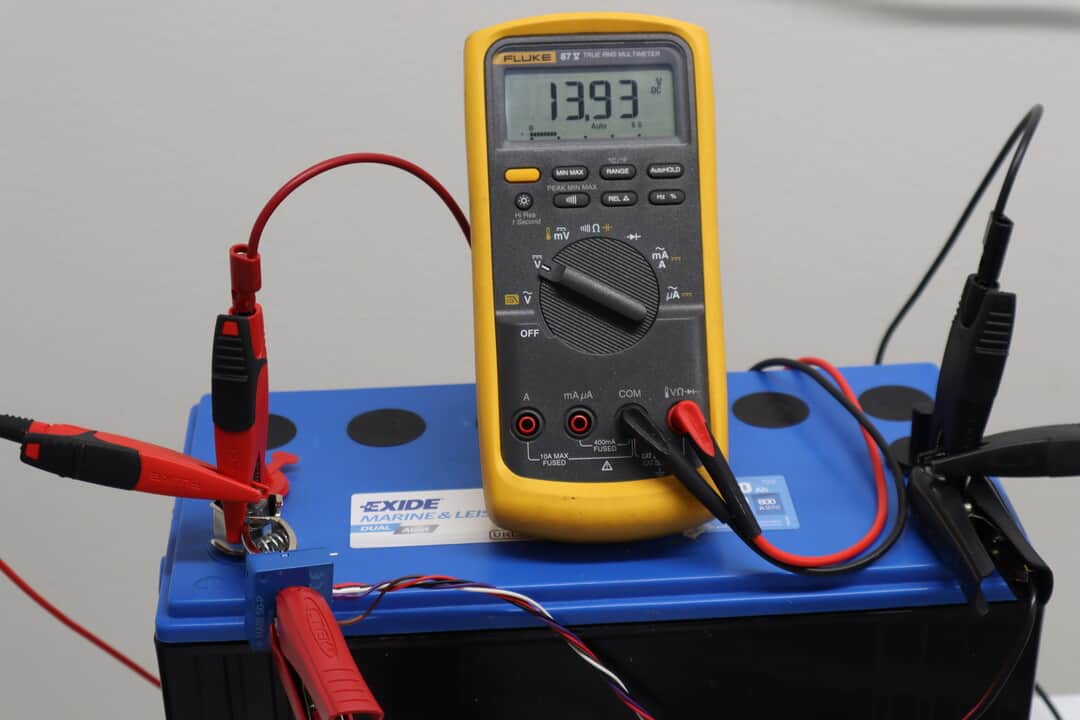AGM batteries have different optimal charging voltages than standard flooded lead-acid batteries. The voltage ranges for AGM’s were roughly indicated in the previous part on AGM charging stages, but we will now examine them more closely. We will also see how the charging voltages should be adjusted with temperature.
In a nutshell, there are two main charging voltages levels for AGM batteries: the absorption voltage, which is the full charging voltage, and the float voltage, which is the maintaining voltage. Both voltages depend on the AGM battery brand, and should be adjusted with temperature. Note that there is no definite bulk charge voltage, because the bulk stage is current-controlled.
If you are not familiar with the terms absorption and float, you may want to check the first part of the series before reading on.
Absorption voltage (Stage 2)
Absorption voltage is the full charging voltage that the charger reaches at the end of the bulk charge stage and sustains through the absorption stage. It is often somewhat misleadingly quoted just as “charging voltage” – the bulk stage, which is most of the charging, actually happens at a much lower voltage.
The optimal absorption voltages for AGM batteries are between 14.2V and 14.9V. Battery manufacturers give slightly different absorption voltages (or voltage ranges) for their AGM units, as listed in the table below. For reference, the table also includes the absorption voltages I measured from two chargers in AGM mode and links to the chargers in Amazon. (Workshoppist.com is an Amazon Associate. As an Amazon Associate we earn from qualifying purchases.)
For 12V standard batteries, Mastervolt specifies a single voltage of 14.25V, while Mighty Max and UPG give a ranges of 14.4V to 14.7V and 14.6V to 14.8V, respectively. Victron specifies two ranges: 14.2V…14.6V for a “normal” charging cycle, and 14.6V…14.9V for fast.
I recommend you use the middle of these ranges as a starting point. If your AGM brand is not listed, a default absorption voltage of 14.5V at +25°C (+77°F) is probably a good choice.
| AGM ABSORPTION VOLTAGES Battery brand | Absorption voltage* @ 25°C/+77°F | 24V units |
|---|---|---|
| Mastervolt | 14.25V | 28.5V |
| Mighty Max | 14.4…14.7V | 28.8…29.4V |
| UPG | 14.6…14.8V | 29.2…29.6V |
| Victron (fast) | 14.2…14.6V (14.6…14.9V) | 28.4…29.2V (29.2…29.8V) |
| Chargers: | ||
| Ctek (MXS 10) | 15.0V** | |
| Victron (Blue Smart IP22 30A) | 14.5V** | |
| (links to Amazon) | *temperature- dependent | **measured, at 25°C/+77°F |
Note that the optimal absorption voltage of AGM batteries depends on temperature – see temperature compensation below.
Float voltage (Stage 3)
Float voltage is the charging voltage for the last “float” stage of AGM battery charging. Its purpose is to compensate for self-discharge and keep the battery fully charged and in good condition; the float voltage this is the conventionally recommended storage voltage of the battery.
Float voltages specified for 12V AGM batteries are between 13.2V and 13.8V, and vary slightly with the manufacturer. Mastervolt gives a single value of 13.8V, while Mighty Max, UPG and Victron give ranges of 13.2V to 13.8V, 13.6V to 13.8V and 13.5V to 13.8V, respectively. The table below summarizes the float voltage ranges for 12V and 24V batteries.
| AGM FLOAT VOLTAGES Battery brand | Float voltage* @ 25°C/+77°F | 24V units |
|---|---|---|
| Mastervolt | 13.8V | 27.6V |
| Mighty Max | 13.2…13.8V | 26.4…27.6V |
| UPG | 13.6…13.8V | 27.2…27.6V |
| Victron | 13.5…13.8V | 27.0…27.6V |
| Chargers: | ||
| Ctek (MXS 10) | 13.8V** | |
| Victron (Blue Smart IP22 30A) | 13.9V** | |
| (links to Amazon) | *temperature- dependent | **measured, at 25°C/+77°F |
If you cannot find a recommendation for your AGM battery brand, a default float voltage of 13.5V at +25°C (+77°F) is probably a good choice. Note that the optimal float voltages depend on temperature and should be corrected with the same temperature compensation factor as the absorption voltages.
The value of the float voltage is actually a compromise between ensuring full charge and avoiding overcharging: a high float voltage value keeps the battery at 100% with certainty, but risks overcharging in long storage periods; a low float voltage is safe, but may not keep the battery full and in the best of conditions. The manufacturer recommended, temperature-compensated float voltage should be the best compromise; when in doubt, prefer a lower voltage.
Temperature compensation
The optimal absorption and float voltages for AGM batteries vary with battery temperature. These voltages are usually given for +25°C or +77°F, and should be adjusted if the battery is warmer or colder. This adjustment is called temperature compensation.
A typical value for AGM battery temperature compensation is -3.9 mV/°C or -2.2 mV/°F per cell. For the common six-cell 12V battery, this translates to -23 mV/°C or -13 mV/°F. Mastervolt specifies a higher rate of -30 mV/ºC or -17 mV/ºF, while Mighty Max gives two temperature compensations: -30 mV/ºC for “cycle use” (i.e. for absorption voltage, I assume) and -20 mV/ºC for “standby use” (i.e. for float voltage). I was not able to find a rate for UPG.
A default temperature correction of -25 mV/°C or -14 mV/°F should be OK for all AGM batteries both for the absorption and float voltages, unless more specific information is available. The table below shows the temperature compensation at this rate for a 12V AGM battery and the temperature-compensated AGM absorption and float voltages for the whole charging temperature range.
| AGM TEMPERATURE COMPENSATION Temperature [°C/°F] | Temp. comp.* [V] | Absorp. voltage* [V] | Float voltage* [V] |
|---|---|---|---|
| (-20°C/-4°F) | (+1.1V) | (15.6V) | (14.6V) |
| -10°C(+14°F) | +0.9V | 15.4V | 14.4V |
| 0°C(+32°F) | +0.6V | 15.1V | 14.1V |
| +10°C(+50°F) | +0.4V | 14.9V | 13.9V |
| +20°C(+68°F) | +0.1V | 14.6V | 13.6V |
| +25°C(+77°F) | 0.0V | 14.5V | 13.5V |
| +30°C(+86°F) | -0.1V | 14.4V | 13.4V |
| +40°C(+104°F) | -0.4V | 14.1V | 13.1V |
| (+50°C/+122°F) | (-0.6V) | (13.9V) | (12.9V) |
| *for 12V units, 2 x for 24V |
Note that the table uses the default absorption and float voltages 14.5V and 13.5V at +25°C (+77°F), respectively; you may want to adjust these based on your battery brand.
Charging warm-up: Also note that high charging rates warm up the battery. As a reference point, Victron specifies that warm-ups of more than +10°C or +18°F should be accounted for in the temperature compensation, and that such increases can be expected at rates above 0.2C.
How to set the voltages
Option 1: Select AGM mode
Most battery chargers do not allow you to select the optimal absorption or float voltages for an AGM battery yourself. The main way you set the voltages is simply by selecting the AGM mode in the charger. Here, you rely on the charger to have reasonable voltage levels programmed in.
The default voltage levels are not optimal but close enough for most AGM battery brands. They are also good enough for charging close to room temperature. However, if you are charging below +15°C or +60°F or above +35°C or 95°F, it is better to opt for an adjustable charger.
Option 2: Set manually
Some advanced chargers and charging systems allow you to set the voltage levels manually; this typically happens by creating a custom charging profile. Here, I recommend you to make adjustments only to apply temperature compensation and battery model specific recommendations. Also make sure you are certain of what you are doing – an AGM battery can be damaged by voltages and currents too far off the normal values.
Option 3: Temperature-sensing chargers

Voltage adjustment for temperature compensation should ideally be done by the charger, based on battery temperature measurement. The reason is that the battery temperature may often change a lot during charging: larger charging currents in the bulk stage will heat up the battery, and in storage the battery may easily swing from +90°F or +30°C in the summer to +10°F or -10°C in deep winter.
Many smart AGM chargers like the Ctek MXS 10 in the picture are capable of adjusting the charging voltages automatically based on sensed temperature. The temperature sensing may be either internal to the charger, or an external sensor unit to be mounted on the battery. Temperature-sensing chargers are very convenient in that they take care of the most important variable – temperature – without user input.
